The Martini's Deceptive Simplicity
How many ounces of vodka are in a martini depends on several factors, but here's the quick answer:
- Classic Dry Martini: 2.5 ounces vodka + 0.5 ounces dry vermouth
- Extra-Dry Martini: 2.5-3 ounces vodka + 0.25 ounces dry vermouth
- Wet Martini: 2 ounces vodka + 1 ounce dry vermouth
- 50/50 Martini: 1.5 ounces vodka + 1.5 ounces dry vermouth
The martini looks simple - just vodka, vermouth, and a garnish in a glass. But behind that crystal-clear appearance lies a world of customization that can dramatically change how much vodka ends up in your drink.
Whether you prefer yours bone-dry like Winston Churchill (who allegedly just glanced at the vermouth bottle) or wet with equal parts spirit and vermouth, the vodka content varies significantly. Add in factors like glassware size, preparation method, and venue, and that "simple" martini becomes surprisingly complex.
The key insight? A single martini often contains the equivalent of two or more standard drinks, since one standard drink equals just 1.5 ounces of spirit. Understanding these measurements helps you make informed choices about both ordering and crafting your perfect martini.
As Sylwester Skóra, founder of Two Flags Vodka, I've spent years perfecting the art of premium vodka production and understanding how many ounces of vodka are in a martini affects the final drinking experience. My expertise in creating ultra-premium, additive-free vodka has taught me that the quality and quantity of your base spirit can make or break this iconic cocktail.
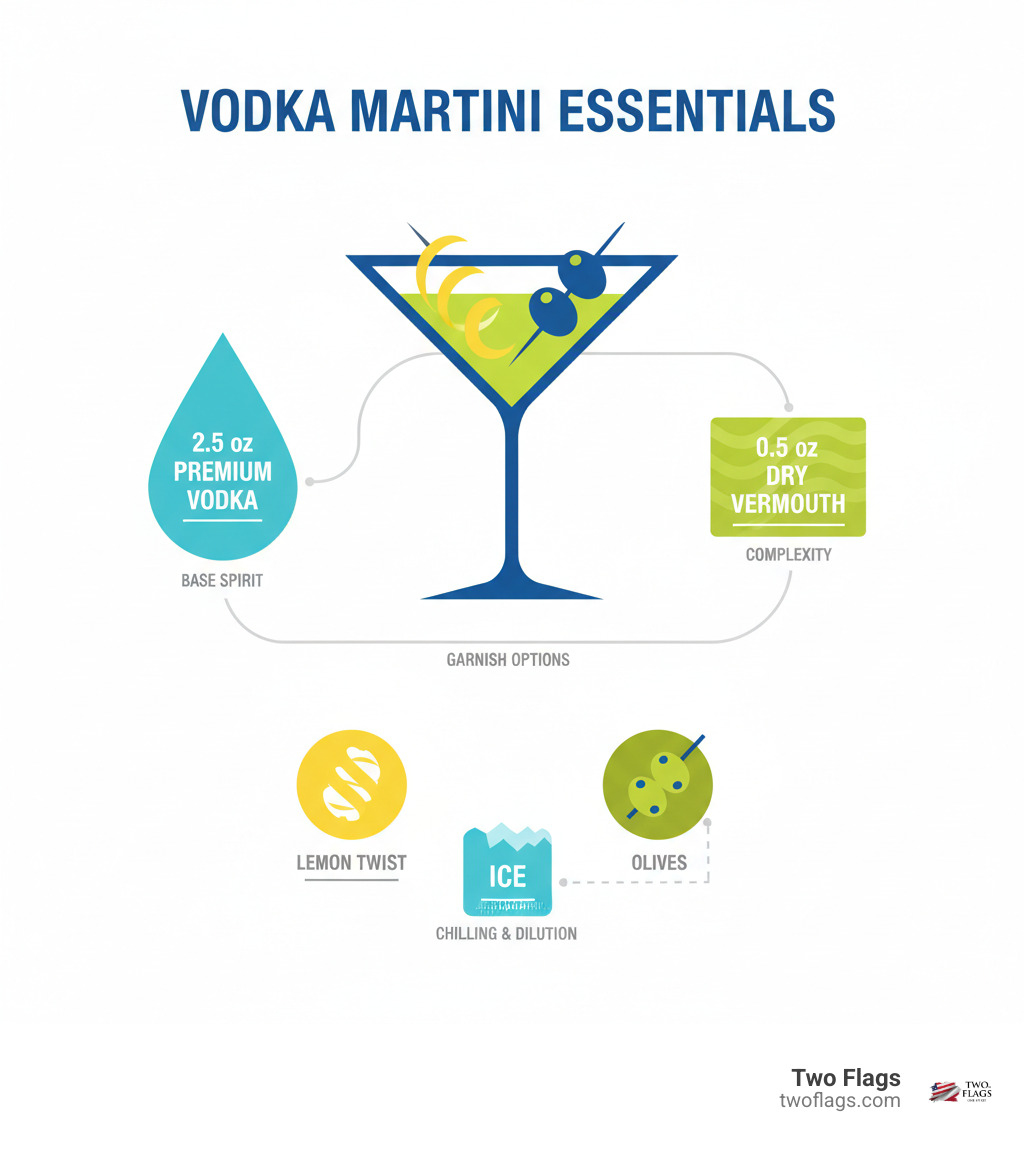
How Many Ounces of Vodka Are in a Martini? The Classic Recipe Breakdown
When we talk about a "classic" martini, it’s like setting a delicious starting line. Most traditional recipes for a vodka martini lean towards a generous pour of vodka, typically around 2 to 2.5 ounces of vodka, balanced with about 0.5 ounces of dry vermouth. This popular 5:1 ratio creates a beautifully spirit-forward drink that’s both crisp and complex. You might even find some recipes suggesting a slightly larger 3 fluid ounces of vodka with 1 fluid ounce of dry vermouth – it all depends on the specific "classic" you're following!
Now, this might sound like a simple pour, but it’s super important to understand what those ounces mean for alcohol content. Think of it this way: a "standard drink" is generally defined as 1.5 ounces of spirits (assuming 40% Alcohol by Volume, or ABV). So, even a classic martini with 2.5 ounces of vodka means you're already enjoying more than one standard drink before the vermouth even joins the party! With Two Flags vodka typically at 40% ABV and vermouth ranging from 14-22% ABV, your martini is truly a potent cocktail. Precision really matters, especially when you're crafting a drink with a premium spirit like our ultra-premium, organic, gluten-free vodka. There's nowhere for flavors to hide, so every single ingredient and measurement counts. For a deeper dive into what makes a vodka truly stand out, check out our guide: Vodka Unveiled: Your Guide to Serving and Sipping.
The Building Blocks: Vodka and Vermouth
At its heart, the martini is a wonderfully simple cocktail, usually just two main ingredients. This simplicity means the quality of those ingredients is absolutely paramount. Our star, vodka, often gets described as a neutral spirit, and that clean canvas is precisely why choosing a high-quality vodka is so crucial. Since there’s little else to mask any off-flavors, a pristine, smooth vodka like Two Flags, free from any harsh alcoholic heat, allows the delicate notes of the vermouth to truly sing. It's where our carefully crafted Two Flags vodka shines, offering a perfect, clean base that lifts the entire drink.
Then there's dry vermouth, vodka's indispensable partner. This fortified wine, infused with a symphony of herbs and botanicals, adds an essential layer of aromatic complexity and a subtle bitterness that perfectly rounds out the cocktail. While a gin martini offers a bold, juniper-forward profile, a vodka martini delivers a cleaner, smoother experience. It lets the nuanced character of the vermouth and your chosen garnish take center stage. Curious about what makes a good vodka? Explore more here: Sip Smarter: Finding What Good Vodka Really Means.
More Than Just One Drink: Understanding Volume and Strength
It’s easy to underestimate a martini's strength. A standard drink contains 1.5 ounces of spirits, so a classic martini with 2.5 ounces of vodka and 0.5 ounces of vermouth is nearly two standard drinks in one glass. The final alcohol content is also affected by dilution from stirring or shaking and the size of the glass, which can vary dramatically by venue. A drier martini with more vodka will naturally be more potent than a wetter one of the same size. Always sip thoughtfully, as a single martini is a potent cocktail. For more about this iconic cocktail, check out A Guide to the Martini cocktail | Martini .
Customizing Your Pour: How Martini Styles Affect Vodka Volume
One of the most delightful things about the martini is how easily you can make it your own. Bartenders and martini lovers have created a whole language to describe different preferences, mostly by playing with the amount of vodka and vermouth. This personal touch directly changes how many ounces of vodka are in a martini and, of course, how it tastes! Let's peek at some common styles and their typical measurements:
| Martini Style | Vodka to Vermouth Ratio | Approximate Vodka (oz) | Approximate Vermouth (oz) | Notes |
|---|---|---|---|---|
| Extra-Dry | 10:1 or more | 2.75-3 | 0.25-0.3 | Minimal vermouth, very spirit-forward |
| Classic Dry | 5:1 | 2.5 | 0.5 | The standard, balanced dry martini |
| Typical Proportioned | 3:1 | 2.25 | 0.75 | Slightly more vermouth than classic dry |
| Wet | 2:1 | 2 | 1 | Noticeably more vermouth, softer |
| 50/50 | 1:1 | 1.5 | 1.5 | Equal parts, bold vermouth presence |
| Churchill | 0:1 (no vermouth) | 3 | 0 | Just chilled vodka, a historical extreme |
How many ounces of vodka are in a martini for a 'Dry' vs. 'Wet' style?
When we talk about a martini being "dry" or "wet," we're simply referring to how much vermouth is in the mix. The less vermouth, the "drier" and more spirit-forward your martini will be.
A Dry Martini typically uses a 5:1 ratio of vodka to dry vermouth. For a 3-ounce drink, that’s 2.5 ounces of vodka and 0.5 ounces of vermouth. This ratio creates a crisp, clean taste that lets the flavor of a premium vodka like Two Flags shine.
An Extra-Dry Martini takes this further with a 10:1 ratio or higher, meaning 2.75 to 3 ounces of vodka with a mere whisper of vermouth (0.25 ounces or less). This style truly celebrates the spirit's pure character.
On the other hand, a Wet Martini has a more generous pour of vermouth, with ratios like 2:1 (2 ounces vodka to 1 ounce vermouth). This makes for a softer, more aromatic drink. For those who truly adore vermouth, the 50/50 Martini uses equal parts, usually 1.5 ounces of Two Flags vodka and 1.5 ounces of vermouth, for a bold and flavorful choice.
Understanding these different styles helps you pinpoint exactly what you're craving. For even more ways to order like a pro, take a peek at: 8 Classic Ways to Order a Martini - The Wine Sisters .
The Dirty, the Filthy, and the Perfect: Other Popular Variations
Beyond just tweaking the vodka-to-vermouth ratio, you can add other ingredients to completely change your martini experience. And yes, these additions can affect the total liquid volume in your glass!
The Dirty Martini is a savory sensation that has really taken off. It gets its unique taste from a splash of olive brine. Usually, about half an ounce of brine is added to your standard martini mix. This gives it that distinct salty kick and a slightly cloudy look. While it adds to the overall liquid, it doesn't typically change how many ounces of vodka are in a martini itself.
If you like your martinis really briny, you're probably a fan of the Filthy Martini. This version takes the "dirty" concept up a notch, using an even larger amount of olive brine – sometimes an ounce or more. The result is a much more pronounced briny flavor and a cloudier drink.
And then there's the Perfect Martini. Now, don't let the name trick you into thinking it's the only perfect martini out there! In cocktail lingo, "perfect" simply means it uses equal parts dry and sweet vermouth. So, instead of just 0.5 ounces of dry vermouth, you might use 0.25 ounces of dry vermouth and 0.25 ounces of sweet vermouth alongside your 2.5 ounces of Two Flags vodka. This creates a slightly richer, sweeter, and wonderfully complex herbal profile.
These variations truly show how incredibly adaptable the martini is. Each one offers a different journey for your taste buds. With a premium vodka like Two Flags, you ensure that every added flavor and nuance is perfectly supported by a clean, smooth, and top-quality base. To explore more about the spirits that lift these delicious drinks, check out: Beyond the Basics: A Guide to Premium Vodka Brands.
The Great Debate: Does Shaking or Stirring Change the Ounces?

Here's something that might surprise you: whether you shake or stir your martini doesn't change how many ounces of vodka are in a martini, but it absolutely affects the final volume and character of your drink. The technique you choose fundamentally changes the dilution, texture, and even appearance of your cocktail.
When you stir or shake a martini with ice, you're doing more than just chilling it. You're also diluting it with melted ice, which is actually a crucial part of the cocktail-making process. This dilution mellows the alcohol and helps all the flavors come together beautifully.
The real difference lies in how much dilution happens and what kind of texture you end up with. Think of it this way: you start with the same amount of vodka, but you'll finish with different amounts of total liquid in your glass.
"Shaken, Not Stirred": The Impact on Your Cocktail
Thanks to James Bond, shaking martinis became famous worldwide. But here's what actually happens when you follow 007's lead with your vodka martini.
Shaking creates more dilution than stirring - sometimes up to 10% more water gets added to your drink. This means your carefully measured vodka gets watered down more than intended. While some people enjoy this lighter approach, it can make your premium Two Flags vodka taste less vibrant.
The appearance changes dramatically when you shake. All that vigorous movement creates tiny air bubbles and can chip off small pieces of ice, giving your martini a cloudy, frothy look. Bartenders call this "bruising" the cocktail, and it's the opposite of the crystal-clear appearance that makes a classic martini so neat.
Texture becomes frothy and aerated instead of smooth and silky. Some people actually prefer this lighter mouthfeel, but it's quite different from the traditional martini experience. The bubbles can also make the drink feel less substantial on your palate.
The myth about "bruising the spirit" isn't entirely accurate for vodka, but over-shaking can definitely change how the flavors come together. For a deeper look at this iconic cocktail's preparation, check out this helpful video: All About the Iconic Martini Cocktail.
The Art of the Stir: Achieving a Silky, Cold Finish
Most professional bartenders and martini enthusiasts prefer stirring, and once you understand why, you'll probably agree.
Stirring gives you complete control over dilution. You can stir for exactly the right amount of time - usually 20 to 30 seconds - to achieve perfect chilling without over-watering your drink. This precision means the vodka content you carefully measured stays more true to your intentions.
The visual result is stunning. A properly stirred martini is crystal clear, allowing the beautiful, clean character of premium vodka like our Two Flags to truly shine through the glass. There's something almost magical about that perfect transparency.
The mouthfeel is completely different. Without all that aeration from shaking, a stirred martini has a smooth, velvety texture that coats your palate beautifully. This silky finish is part of what makes a great martini so satisfying.
Temperature control is actually better with stirring, despite what you might think. While shaking chills faster, proper stirring with plenty of fresh ice gets your martini just as cold. The key is using enough ice and maintaining a steady, deliberate stirring motion with a bar spoon.
To execute the perfect stir, combine your vodka and vermouth in a mixing glass filled with fresh ice. Stir steadily, making sure the liquid moves around all the ice. Then strain into a pre-chilled glass using a julep strainer, which is specifically designed for stirred, all-spirit cocktails.
This careful technique ensures that your precisely measured vodka - whether it's 2.5 ounces for a classic dry or 3 ounces for an extra-dry - gets the respect it deserves. For more insights on enjoying premium vodka in its purest forms, explore our guide: No Mix, No Fuss: Top Vodkas for Sipping Solo.
Glass Half Full? Why Glassware and Venue Dictate Your Drink's Size
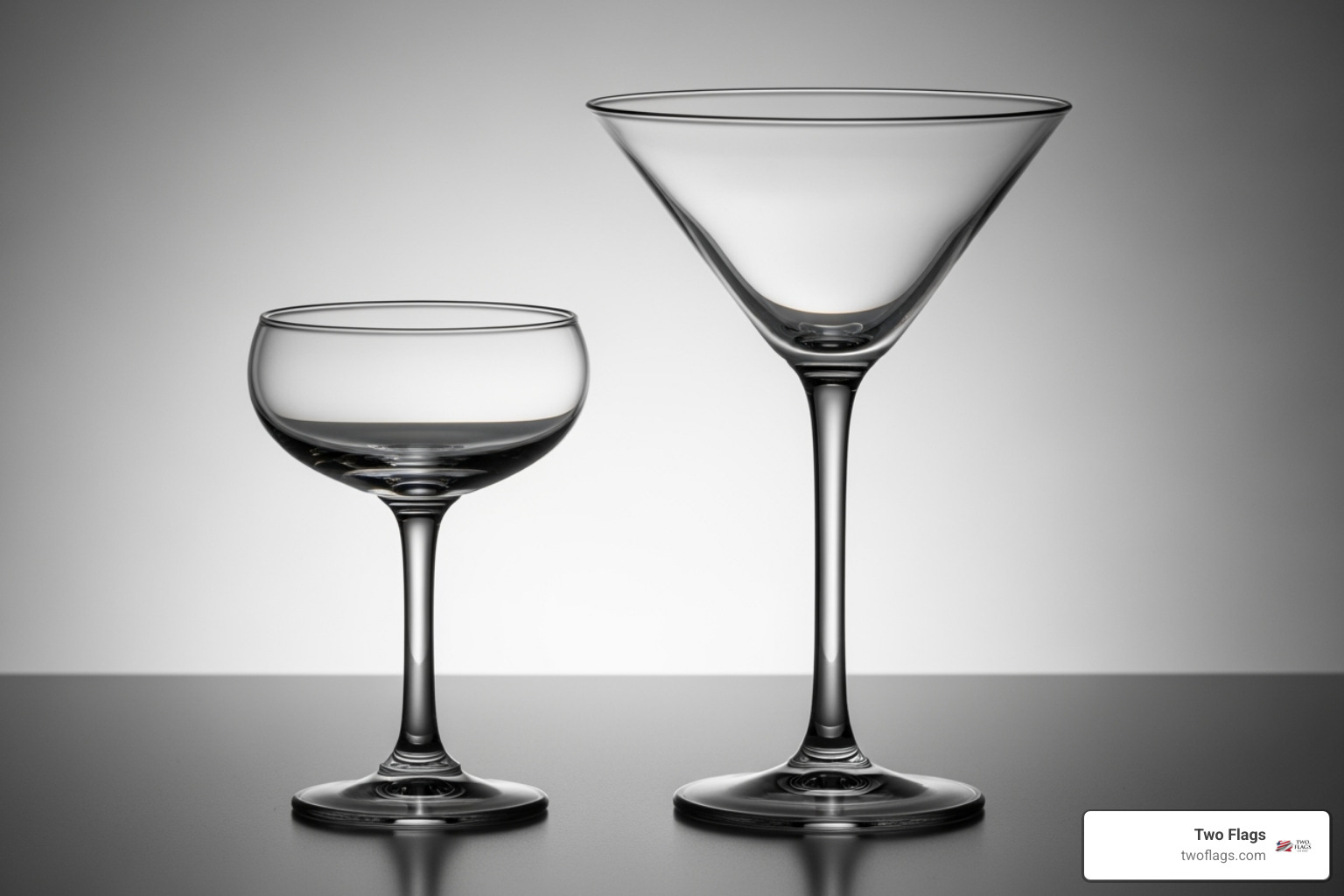
You know, the glass your martini arrives in isn't just a pretty face. It plays a huge part in how you perceive the drink, and most importantly, it dictates how many ounces of vodka are in a martini you're actually getting. Over time, the classic martini glass has changed, and with it, the typical serving size. This means the amount of vodka can really swing depending on where you're enjoying your cocktail.
How many ounces of vodka are in a martini served at a steakhouse vs. a craft bar?
The venue and its glassware significantly impact your martini's size.
A craft cocktail bar typically prioritizes balance, serving martinis in smaller coupe or Nick & Nora glasses (4-5 oz capacity). The drink itself is usually a precise 3-4 ounces, containing about 2.5 to 3.3 ounces of vodka in a classic recipe. This is a refined cocktail equivalent to about two standard drinks.
In contrast, a steakhouse, lounge, or airport bar often uses large, dramatic V-shaped glasses (6-10 oz capacity). Pours are more generous, often reaching 6 to 7.5 ounces of liquid. This means a single drink could contain 5 to 6.25 ounces of vodka, or the equivalent of four to five standard drinks. The setting can dramatically change the amount of Two Flags vodka you're enjoying in one glass.
The Finishing Touch: Garnishes and Presentation
While they don't directly change how many ounces of vodka are in a martini, garnishes are absolutely essential for the complete experience. They add aroma, flavor, and that final visual appeal that makes a martini so inviting.
A lemon twist is a timeless choice. The bright oils from the lemon peel are expressed over your drink, releasing wonderful citrus notes that perfectly complement the clean taste of Two Flags vodka and the dry vermouth. Some even like to rub the peel around the rim of the glass for an extra aromatic touch.
Then there are olives, typically green and served on a cocktail pick. Their briny, savory flavor is a classic partner to a dry martini. Tradition often suggests using an odd number – one or three olives – but never two!
And if you're a fan of a pickled cocktail onion instead of an olive, well, then you're enjoying a Gibson martini!
No matter your chosen garnish, always remember this golden rule: serve your martini in a chilled glass. We highly recommend keeping your martini glasses in the freezer for a few minutes before you pour. This simple step ensures your drink stays perfectly cold and crisp from the first sip to the last, truly enhancing the pure, smooth taste of our premium Two Flags vodka. To find out more about the spirits that lift these drinks, you can read: Raise Your Glass: Top-Rated Vodkas for Discerning Drinkers.
Frequently Asked Questions about Vodka Martinis
We love talking about martinis, and over the years, we've heard some great questions from fellow vodka enthusiasts. Here are the ones that come up most often when people are trying to perfect their martini game.
What is the best ratio of vodka to vermouth in a martini?
Here's the thing about martini ratios - there's no single "perfect" answer because everyone's taste buds are different. That said, a classic 5:1 ratio makes an excellent starting point for most people. This means 5 parts vodka to 1 part dry vermouth, giving you that traditional dry martini balance.
If you're someone who barely wants to taste the vermouth, go drier with a 10:1 or even 12:1 ratio. Some people prefer just a "whisper" of vermouth - literally rinsing the glass and pouring it out before adding the vodka. On the flip side, if you enjoy the herbal complexity that vermouth brings, try a wetter martini with a 2:1 or even 1:1 ratio.
Our advice? Start with that classic 5:1 and adjust from there. When you're using a premium vodka like Two Flags One Spirit, you'll be able to taste the subtle differences each ratio creates. The clean, smooth character of our vodka provides the perfect canvas for experimenting.
What is the historical origin of the Vodka Martini?
The vodka martini has a fascinating backstory that's quite different from its gin-based cousin. The original martini, which dates back to at least 1883, was all about gin. Vodka was practically unknown in the Western world at that time, even though it had been popular in Eastern Europe for centuries.
The vodka version, sometimes called a "Kangaroo Cocktail," emerged as what bartenders called a "1930s experiment." But it really took off in the mid-20th century as American drinkers became more adventurous and vodka started appearing on bar shelves across the country.
Of course, we can't talk about vodka martinis without mentioning James Bond. When Sean Connery ordered his "medium dry vodka martini... shaken not stirred" in the 1962 film Dr. No, it cemented the vodka martini's place in cocktail culture forever. Ian Fleming's fictional spy turned what was once an experimental drink into an icon.
So while gin can claim the original martini title, the vodka martini has carved out its own celebrated place in cocktail history.
What is the difference between a Gin and Vodka Martini?
The difference comes down to personality - and how many ounces of vodka are in a martini versus gin changes the entire drinking experience.
Gin martinis are like meeting someone with a strong personality right away. Gin is packed with botanicals, especially juniper, along with other herbs, spices, and citrus. When you sip a gin martini, you're getting all those complex, aromatic flavors hitting your palate at once. It's bold, herbaceous, and definitely makes a statement.
Vodka martinis are the smooth operators of the cocktail world. Since vodka is considered a neutral spirit, it creates a cleaner, more refined drinking experience. While premium vodkas like our Two Flags One Spirit do have subtle character from their ingredients and careful distillation, they don't compete with the other flavors in your glass.
This means in a vodka martini, you can actually taste the nuances of your vermouth and appreciate your garnish - whether that's the citrus oils from a lemon twist or the briny punch of olives. It's perfect for people who want a sophisticated cocktail without the assertive botanical notes that gin brings to the party.
Think of it this way: gin martinis are for when you want the spirit to lead the conversation, while vodka martinis let all the ingredients have their say.
Conclusion: Crafting Your Perfect Martini
So, how many ounces of vodka are in a martini? As we've finded throughout this journey, there's no single answer that fits every glass. The beauty lies in understanding that your perfect martini is entirely personal.
The classic 2.5 ounces of vodka in a traditional dry martini serves as your baseline. From there, you can venture into extra-dry territory with 3 ounces of vodka and just a whisper of vermouth, or explore the wet martini world with equal parts spirit and vermouth at 1.5 ounces each.
Your preparation method matters too. Stirring creates that crystal-clear, silky finish that showcases premium vodka at its best, while shaking (despite James Bond's preference) adds dilution and cloudiness that many purists avoid.
Then there's the venue factor. That neat coupe at a craft cocktail bar might hold a refined 3-ounce martini, while the dramatic V-shaped glass at your favorite steakhouse could easily contain 6 to 7 ounces of liquid. This means you could be sipping anywhere from 2 to 5 standard drinks in what looks like a single cocktail.
The martini teaches us that simplicity doesn't mean basic. With just vodka, vermouth, and a garnish, you're creating something that can be endlessly customized to your taste. Whether you prefer bone-dry like Churchill or wet with equal parts, understanding these measurements puts you in control of your drinking experience.
Quality makes all the difference in a drink this simple. Two Flags Vodka provides that clean, premium foundation every great martini deserves. Our organic, gluten-free vodka, authentically crafted in Poland and recognized as "Exceptional" by the Beverage Testing Institute, ensures that every variation you try showcases the pure, smooth character that makes vodka martinis so beloved.
Now you can confidently walk into any bar and order your martini exactly how you want it. Or better yet, craft the perfect one at home, knowing precisely how many ounces of vodka are in a martini based on your personal style. For everything you need to know about selecting the right vodka for your home bar, check out: Your Ultimate Guide to Picking the Perfect Vodka.




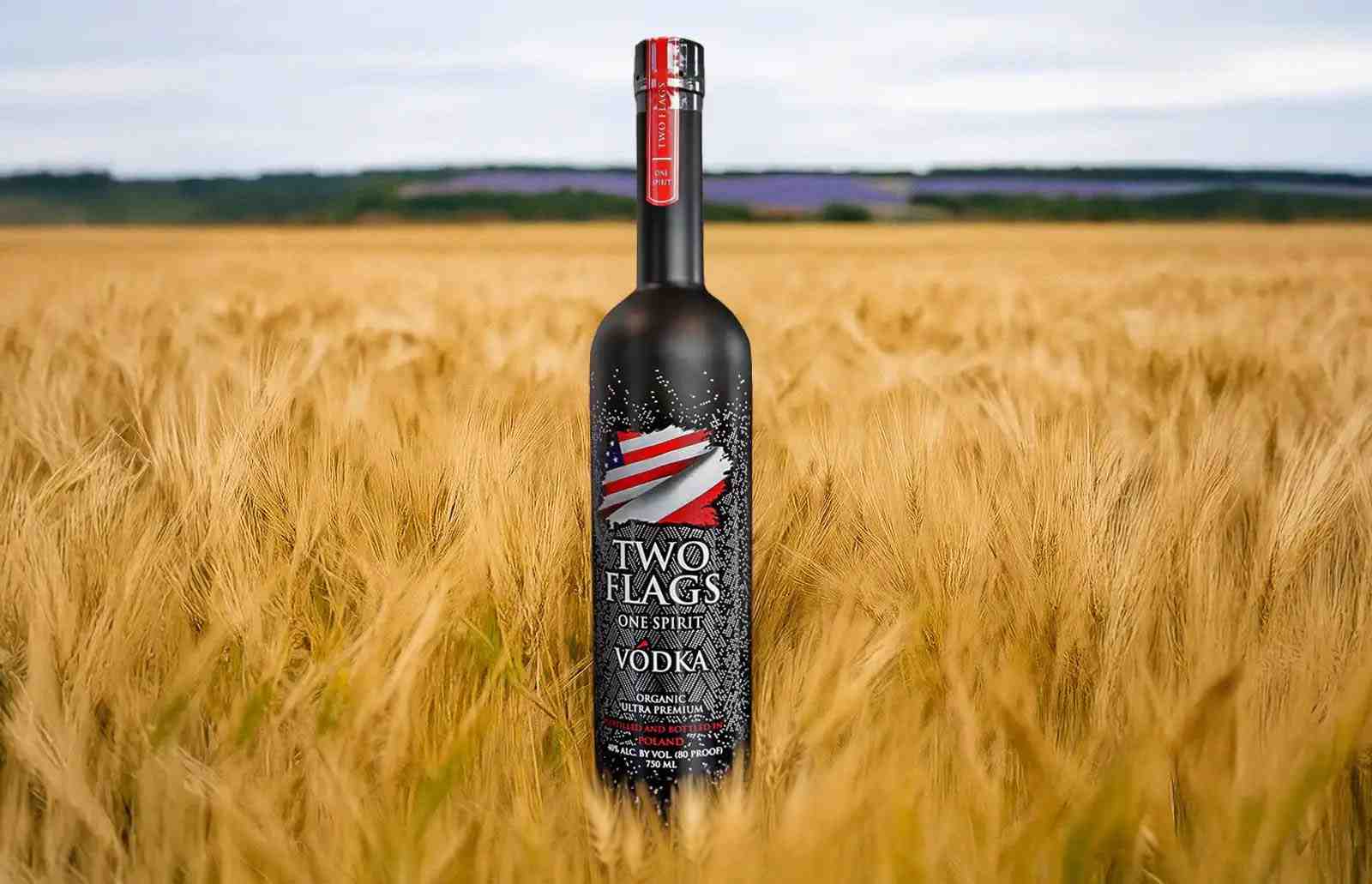
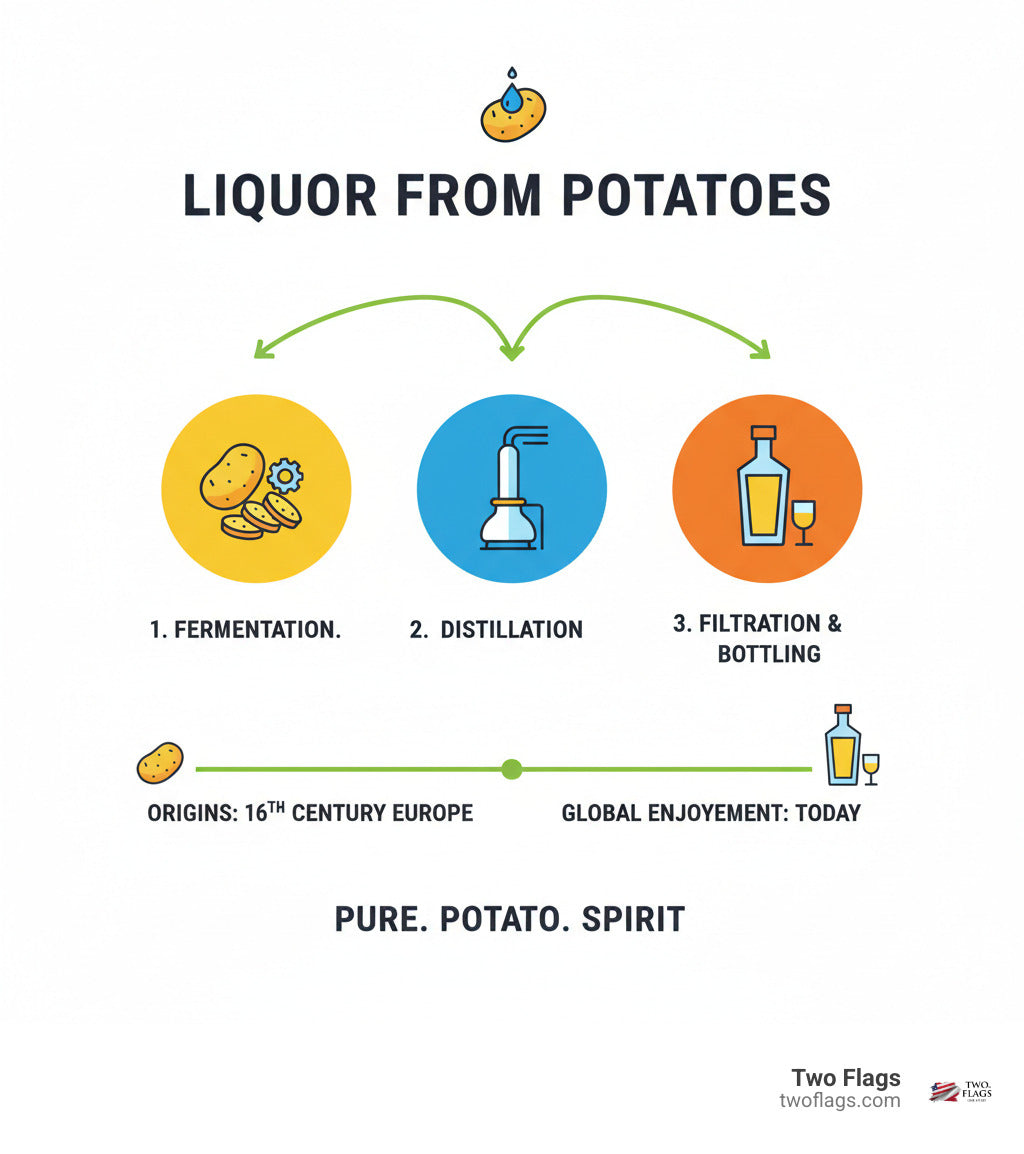
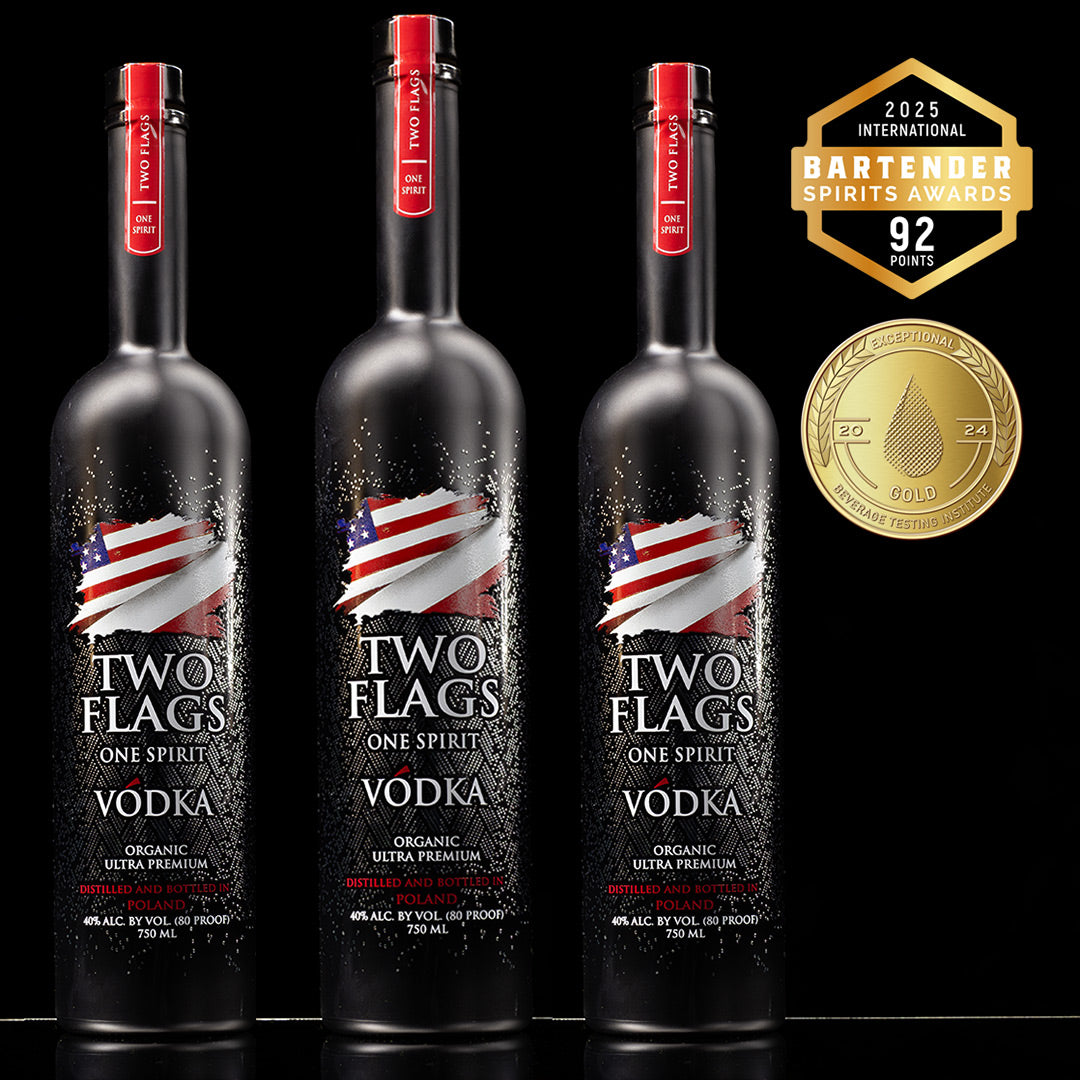
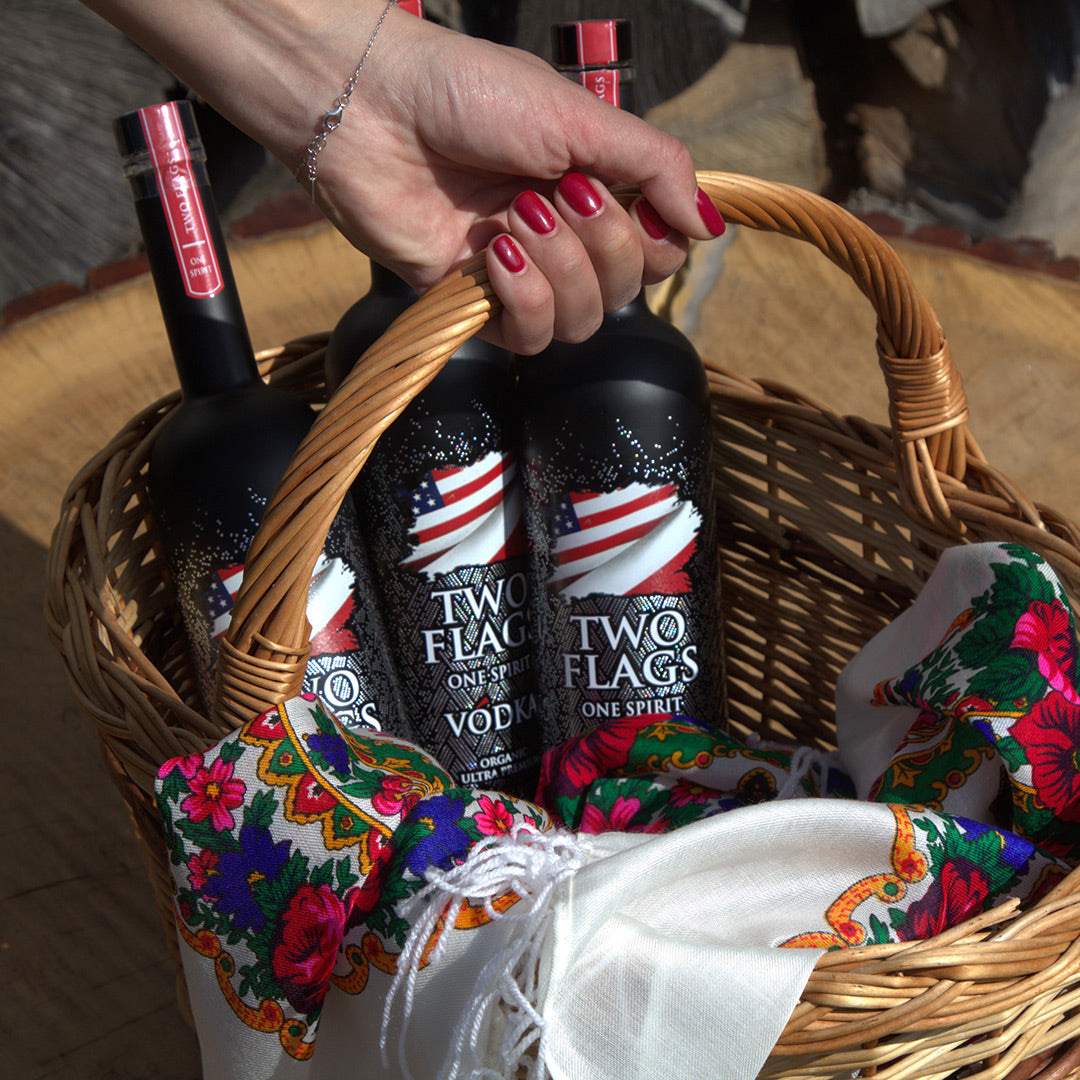
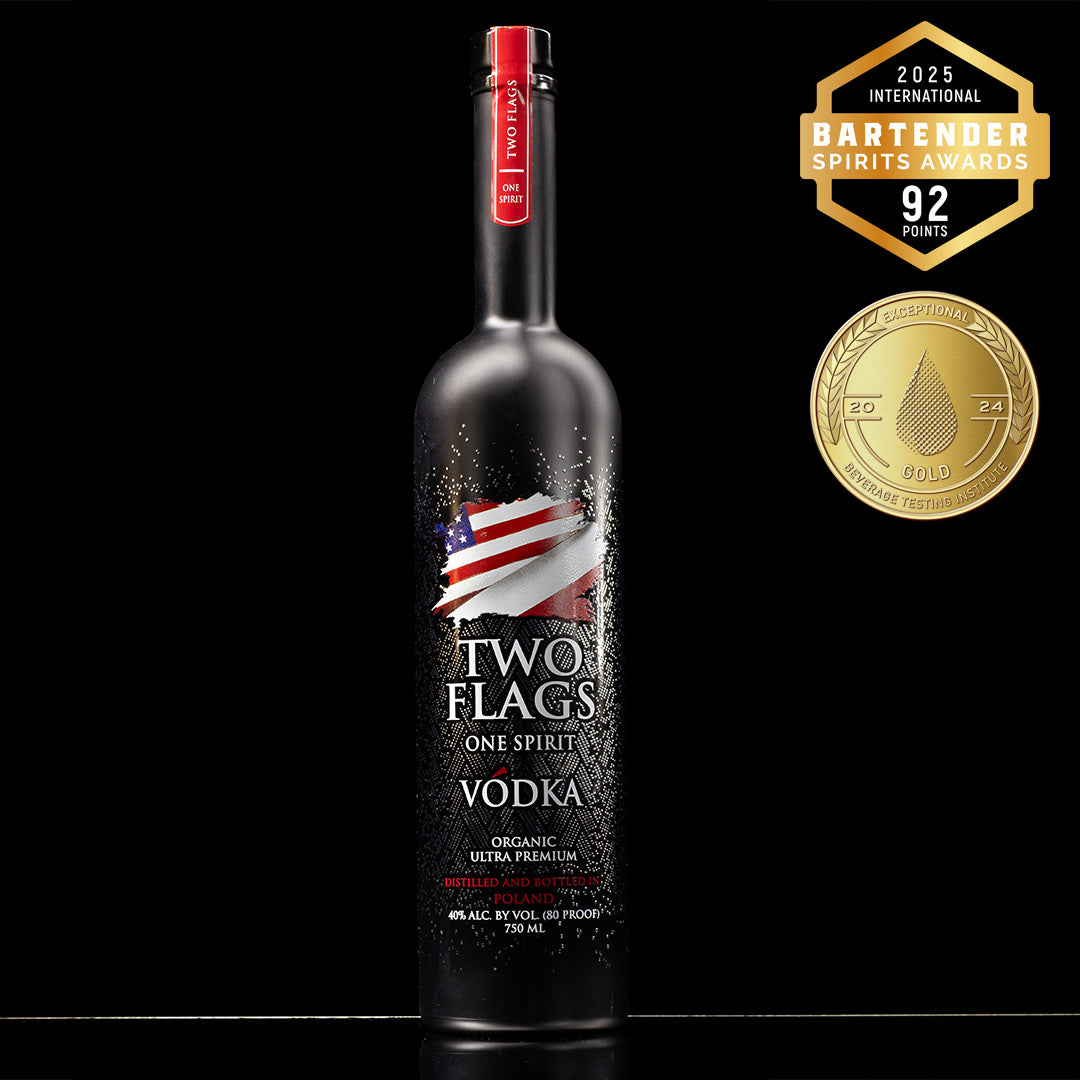
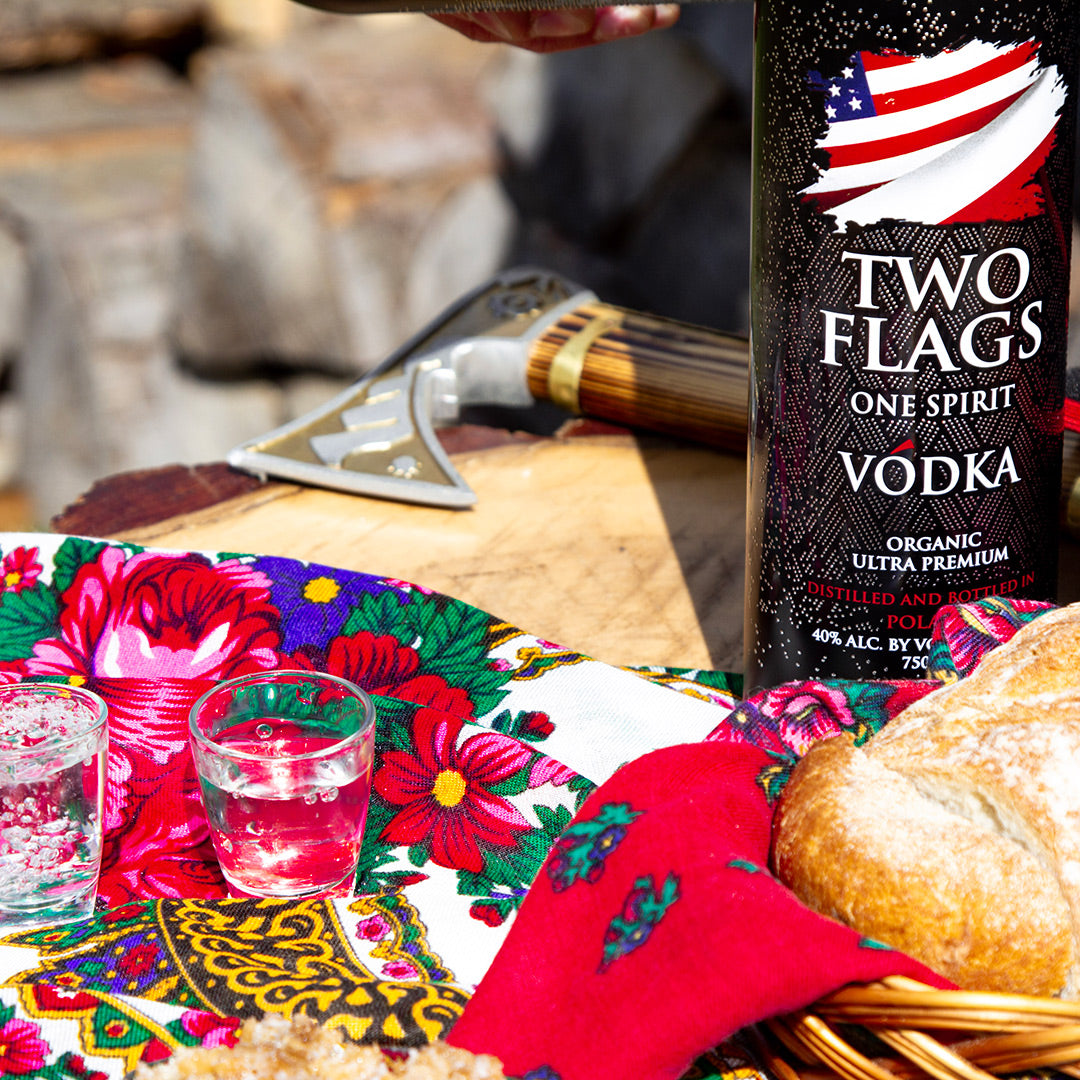
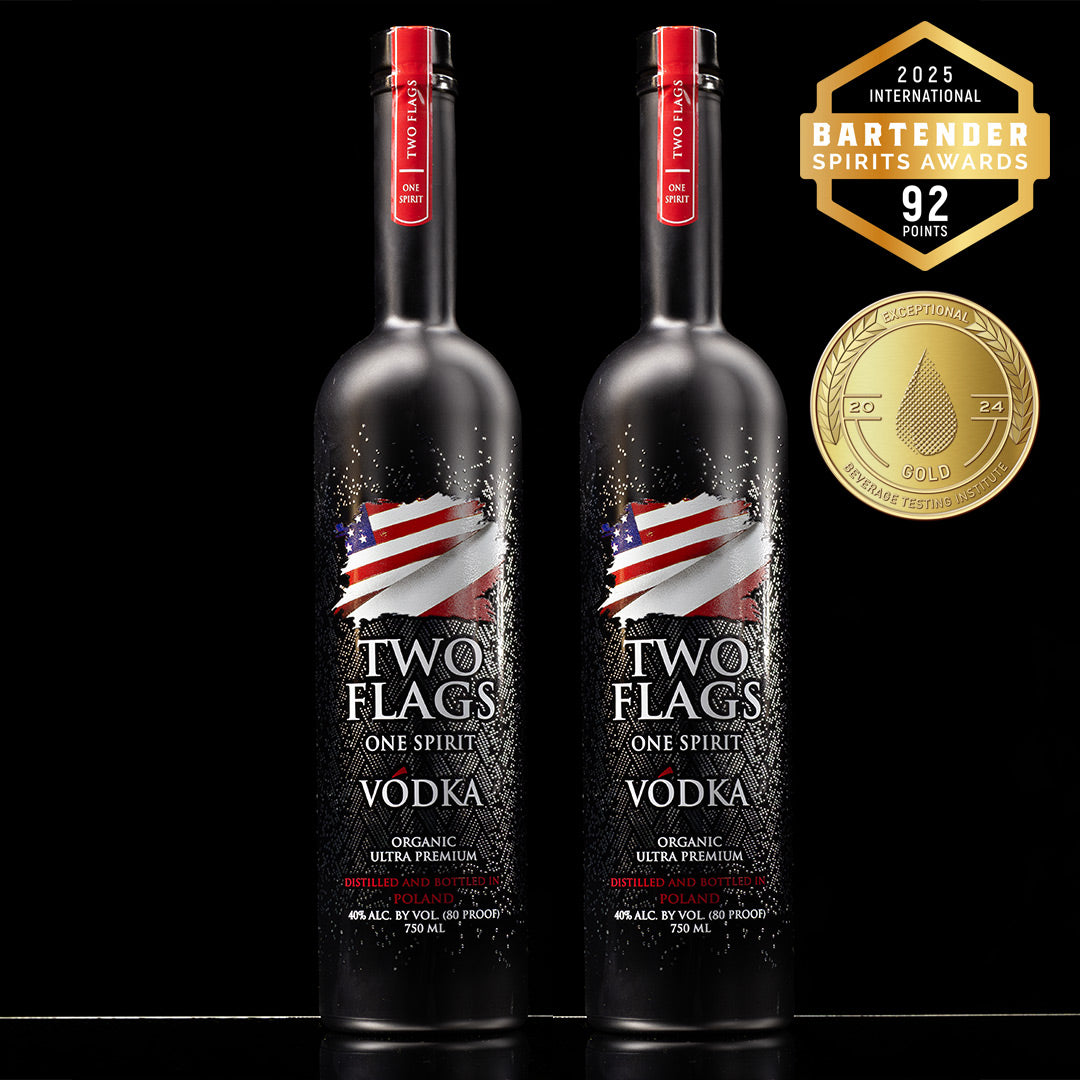
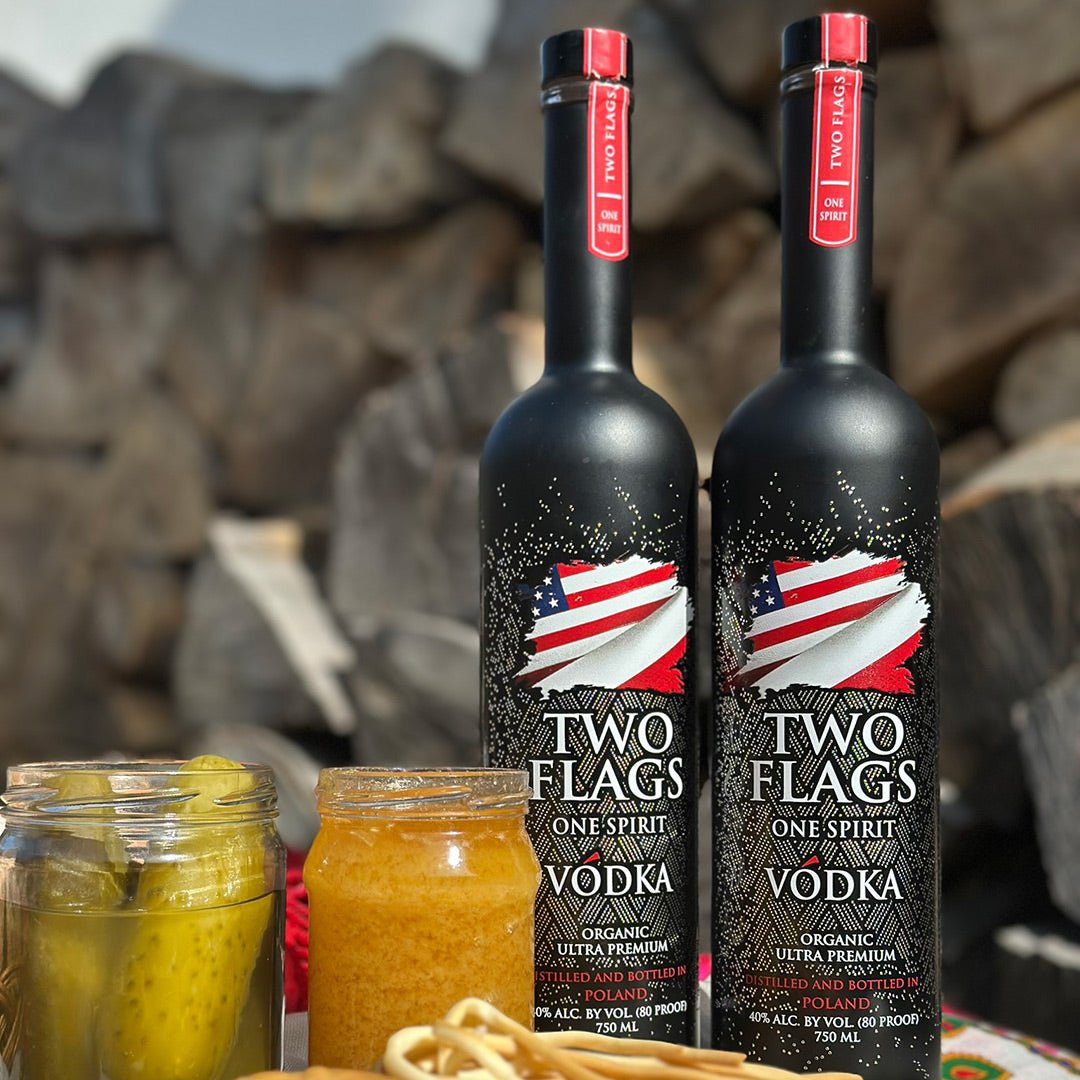
Zostaw komentarz
Ta strona jest chroniona przez hCaptcha i obowiązują na niej Polityka prywatności i Warunki korzystania z usługi serwisu hCaptcha.